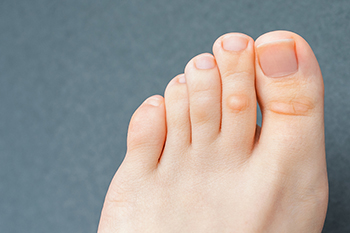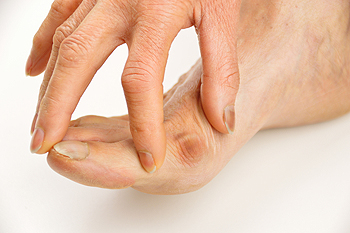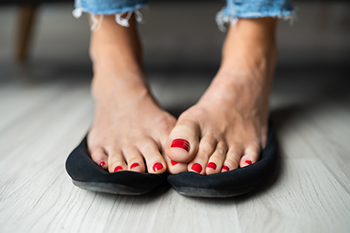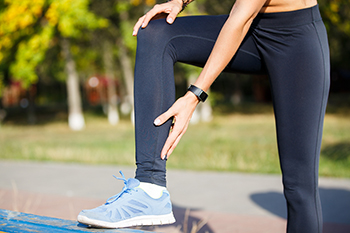Items filtered by date: April 2022
Foot Corn Treatment

A foot corn is a hardened layer of skin that develops on the foot due to friction or pressure. Foot corns can develop below the toenail bed, between toes, or on the sides and bottom of the feet. Most often, corns develop from snug shoes and/or socks and become aggravated from prolonged periods of standing or walking, body weight, and continual friction, causing them to become painful. If you suspect you have a corn on your foot your first action should be to change footwear to those that fit properly. You can try to soften a corn by carefully soaking the affected foot in warm water with Epsom salts, drying the foot thoroughly, and moisturizing it daily. Once softened, you can try to gently rub the corn on the bottom of the foot with a pumice stone. Using an emery board, if the corn is located between the toes, you can apply a vegetable-based oil and cover it with a corn pad that can be obtained from a drug store. Continue this treatment for a couple of weeks. However, if there is pain associated with home treatment or the corn persists or worsens, it is suggested that you seek guidance from a qualified podiatrist to assist in treating the corn.
Corns can make walking very painful and should be treated immediately. If you have questions regarding your feet and ankles, contact Dr. Thomas E. Silver of Westwood Foot Clinic. Our doctor will treat your foot and ankle needs.
Corns: What Are They? And How Do You Get Rid of Them?
Corns are thickened areas on the skin that can become painful. They are caused by excessive pressure and friction on the skin. Corns press into the deeper layers of the skin and are usually round in shape.
Ways to Prevent Corns
There are many ways to get rid of painful corns such as:
- Wearing properly fitting shoes that have been measured by a professional
- Wearing shoes that are not sharply pointed or have high heels
- Wearing only shoes that offer support
Treating Corns
Although most corns slowly disappear when the friction or pressure stops, this isn’t always the case. Consult with your podiatrist to determine the best treatment option for your case of corns.
If you have any questions please feel free to contact our office located in Golden Valley, MN . We offer the newest diagnostic and treatment technologies for all your foot and ankle needs.
Treatment Options for Sweaty Feet
People who have feet that sweat excessively may have a condition that is known as plantar hyperhidrosis. It may be the result of a neurological or endocrine disorder and can be quite uncomfortable. There are several treatment options, and this can depend on the severity of this ailment. Surgery may be a viable option for successfully removing the sweat glands. Patients who are afflicted with this condition often keep an extra pair of shoes and socks close by. It can be professionally and socially disabling, and many patients who have this condition are often embarrassed. If you think you may have hyperhidrosis, it is suggested that you schedule an appointment with a podiatrist who can offer you the correct treatment solutions.
If you are suffering from hyperhidrosis contact Dr. Thomas E. Silver of Westwood Foot Clinic. Our doctor can provide the care you need to attend to all of your foot and ankle needs.
Hyperhidrosis of the Feet
Hyperhidrosis is a rare disorder that can cause people to have excessive sweating of their feet. This can usually occur all on its own without rigorous activity involved. People who suffer from hyperhidrosis may also experience sweaty palms.
Although it is said that sweating is a healthy process meant to cool down the body temperature and to maintain a proper internal temperature, hyperhidrosis may prove to be a huge hindrance on a person’s everyday life.
Plantar hyperhidrosis is considered to be the main form of hyperhidrosis. Secondary hyperhidrosis can refer to sweating that occurs in areas other than the feet or hands and armpits. Often this may be a sign of it being related to another medical condition such as menopause, hyperthyroidism and even Parkinson’s disease.
In order to alleviate this condition, it is important to see your doctor so that they may prescribe the necessary medications so that you can begin to live a normal life again. If this is left untreated, it is said that it will persist throughout an individual’s life.
A last resort approach would be surgery, but it is best to speak with your doctor to find out what may be the best treatment for you.
If you have any questions please feel free to contact our office located in Golden Valley, MN . We offer the newest diagnostic and treatment technologies for all your foot and ankle needs.
What Causes Achilles Tendinitis
The Achilles tendon connects the two large calf muscles at the back of the leg to the heel bone. It makes flexing the foot possible, along with walking, running, and jumping. When the Achilles tendon becomes damaged, swollen, and painful, it is known as Achilles tendinitis or Achilles tendinopathy. This condition can occur for a variety of reasons including failing to warm up the calf muscles prior to working out, wearing shoes that do not support the feet properly, suddenly increasing the intensity/amount of physical activity, running too often or on hard surfaces, participating in activities with a lot of jumping, or accidentally turning your foot in or out abruptly. Other risk factors for Achilles tendinitis include being a middle-aged or older adult or having flat feet or a growth or heel spur at the back of the heel (both of which can irritate or put pressure on the tendon). If you believe you have Achilles tendinitis, make an appointment with your podiatrist as soon as possible to begin treatment.
Achilles tendon injuries need immediate attention to avoid future complications. If you have any concerns, contact Dr. Thomas E. Silver of Westwood Foot Clinic. Our doctor can provide the care you need to keep you pain-free and on your feet.
What Is the Achilles Tendon?
The Achilles tendon is a tendon that connects the lower leg muscles and calf to the heel of the foot. It is the strongest tendon in the human body and is essential for making movement possible. Because this tendon is such an integral part of the body, any injuries to it can create immense difficulties and should immediately be presented to a doctor.
What Are the Symptoms of an Achilles Tendon Injury?
There are various types of injuries that can affect the Achilles tendon. The two most common injuries are Achilles tendinitis and ruptures of the tendon.
Achilles Tendinitis Symptoms
- Inflammation
- Dull to severe pain
- Increased blood flow to the tendon
- Thickening of the tendon
Rupture Symptoms
- Extreme pain and swelling in the foot
- Total immobility
Treatment and Prevention
Achilles tendon injuries are diagnosed by a thorough physical evaluation, which can include an MRI. Treatment involves rest, physical therapy, and in some cases, surgery. However, various preventative measures can be taken to avoid these injuries, such as:
- Thorough stretching of the tendon before and after exercise
- Strengthening exercises like calf raises, squats, leg curls, leg extensions, leg raises, lunges, and leg presses
If you have any questions please feel free to contact our office located in Golden Valley, MN . We offer the newest diagnostic tools and technology to treat your foot and ankle needs.
What Causes Achilles Tendinitis
The Achilles tendon connects the two large calf muscles at the back of the leg to the heel bone. It makes flexing the foot possible, along with walking, running, and jumping. When the Achilles tendon becomes damaged, swollen, and painful, it is known as Achilles tendinitis or Achilles tendinopathy. This condition can occur for a variety of reasons including failing to warm up the calf muscles prior to working out, wearing shoes that do not support the feet properly, suddenly increasing the intensity/amount of physical activity, running too often or on hard surfaces, participating in activities with a lot of jumping, or accidentally turning your foot in or out abruptly. Other risk factors for Achilles tendinitis include being a middle-aged or older adult or having flat feet or a growth or heel spur at the back of the heel (both of which can irritate or put pressure on the tendon). If you believe you have Achilles tendinitis, make an appointment with your podiatrist as soon as possible to begin treatment.
Achilles tendon injuries need immediate attention to avoid future complications. If you have any concerns, contact Dr. Thomas E. Silver of Westwood Foot Clinic. Our doctor can provide the care you need to keep you pain-free and on your feet.
What Is the Achilles Tendon?
The Achilles tendon is a tendon that connects the lower leg muscles and calf to the heel of the foot. It is the strongest tendon in the human body and is essential for making movement possible. Because this tendon is such an integral part of the body, any injuries to it can create immense difficulties and should immediately be presented to a doctor.
What Are the Symptoms of an Achilles Tendon Injury?
There are various types of injuries that can affect the Achilles tendon. The two most common injuries are Achilles tendinitis and ruptures of the tendon.
Achilles Tendinitis Symptoms
- Inflammation
- Dull to severe pain
- Increased blood flow to the tendon
- Thickening of the tendon
Rupture Symptoms
- Extreme pain and swelling in the foot
- Total immobility
Treatment and Prevention
Achilles tendon injuries are diagnosed by a thorough physical evaluation, which can include an MRI. Treatment involves rest, physical therapy, and in some cases, surgery. However, various preventative measures can be taken to avoid these injuries, such as:
- Thorough stretching of the tendon before and after exercise
- Strengthening exercises like calf raises, squats, leg curls, leg extensions, leg raises, lunges, and leg presses
If you have any questions please feel free to contact our office located in Golden Valley, MN . We offer the newest diagnostic tools and technology to treat your foot and ankle needs.
Read more about What are Achilles Tendon InjuriesWhy Live with Pain and Numbness in Your Feet?
Permanent Removal May Be Necessary for Bunions
 A bunion is defined as a bony lump on the side of the big toe. It can come from genetic factors, wearing shoes that do not fit correctly, or possibly from enduring a toe injury. As the bunion grows, it can push the big toe closer to the second toe, and larger footwear often needs to be worn. Some patients experience pain and discomfort, and the bunion and surrounding areas can become tender, red, and inflamed. It can be difficult to complete daily activities, and it may impact the ability to exercise. It can help to maintain the correct weight to keep unnecessary pressure off of the foot. If the bunion is severe, surgery may be necessary for permanent removal, and this is referred to as a bunionectomy. If you think you may have a bunion, it is strongly suggested that you visit a podiatrist who can help you to find relief.
A bunion is defined as a bony lump on the side of the big toe. It can come from genetic factors, wearing shoes that do not fit correctly, or possibly from enduring a toe injury. As the bunion grows, it can push the big toe closer to the second toe, and larger footwear often needs to be worn. Some patients experience pain and discomfort, and the bunion and surrounding areas can become tender, red, and inflamed. It can be difficult to complete daily activities, and it may impact the ability to exercise. It can help to maintain the correct weight to keep unnecessary pressure off of the foot. If the bunion is severe, surgery may be necessary for permanent removal, and this is referred to as a bunionectomy. If you think you may have a bunion, it is strongly suggested that you visit a podiatrist who can help you to find relief.
If you are suffering from bunion pain, contact Dr. Thomas E. Silver of Westwood Foot Clinic. Our doctor can provide the care you need to keep you pain-free and on your feet.
What Is a Bunion?
Bunions are painful bony bumps that usually develop on the inside of the foot at the joint of the big toe. As the deformity increases over time, it may become painful to walk and wear shoes. Women are more likely to exacerbate existing bunions since they often wear tight, narrow shoes that shift their toes together. Bunion pain can be relieved by wearing wider shoes with enough room for the toes.
Causes
- Genetics – some people inherit feet that are more prone to bunion development
- Inflammatory Conditions - rheumatoid arthritis and polio may cause bunion development
Symptoms
- Redness and inflammation
- Pain and tenderness
- Callus or corns on the bump
- Restricted motion in the big toe
In order to diagnose your bunion, your podiatrist may ask about your medical history, symptoms, and general health. Your doctor might also order an x-ray to take a closer look at your feet. Nonsurgical treatment options include orthotics, padding, icing, changes in footwear, and medication. If nonsurgical treatments don’t alleviate your bunion pain, surgery may be necessary.
If you have any questions, please feel free to contact our office located in Golden Valley, MN . We offer the newest diagnostic and treatment technologies for all your foot care needs.
Read more about What Are Bunions?Permanent Removal May Be Necessary for Bunions
 A bunion is defined as a bony lump on the side of the big toe. It can come from genetic factors, wearing shoes that do not fit correctly, or possibly from enduring a toe injury. As the bunion grows, it can push the big toe closer to the second toe, and larger footwear often needs to be worn. Some patients experience pain and discomfort, and the bunion and surrounding areas can become tender, red, and inflamed. It can be difficult to complete daily activities, and it may impact the ability to exercise. It can help to maintain the correct weight to keep unnecessary pressure off of the foot. If the bunion is severe, surgery may be necessary for permanent removal, and this is referred to as a bunionectomy. If you think you may have a bunion, it is strongly suggested that you visit a podiatrist who can help you to find relief.
A bunion is defined as a bony lump on the side of the big toe. It can come from genetic factors, wearing shoes that do not fit correctly, or possibly from enduring a toe injury. As the bunion grows, it can push the big toe closer to the second toe, and larger footwear often needs to be worn. Some patients experience pain and discomfort, and the bunion and surrounding areas can become tender, red, and inflamed. It can be difficult to complete daily activities, and it may impact the ability to exercise. It can help to maintain the correct weight to keep unnecessary pressure off of the foot. If the bunion is severe, surgery may be necessary for permanent removal, and this is referred to as a bunionectomy. If you think you may have a bunion, it is strongly suggested that you visit a podiatrist who can help you to find relief.
If you are suffering from bunion pain, contact Dr. Thomas E. Silver of Westwood Foot Clinic. Our doctor can provide the care you need to keep you pain-free and on your feet.
What Is a Bunion?
Bunions are painful bony bumps that usually develop on the inside of the foot at the joint of the big toe. As the deformity increases over time, it may become painful to walk and wear shoes. Women are more likely to exacerbate existing bunions since they often wear tight, narrow shoes that shift their toes together. Bunion pain can be relieved by wearing wider shoes with enough room for the toes.
Causes
- Genetics – some people inherit feet that are more prone to bunion development
- Inflammatory Conditions - rheumatoid arthritis and polio may cause bunion development
Symptoms
- Redness and inflammation
- Pain and tenderness
- Callus or corns on the bump
- Restricted motion in the big toe
In order to diagnose your bunion, your podiatrist may ask about your medical history, symptoms, and general health. Your doctor might also order an x-ray to take a closer look at your feet. Nonsurgical treatment options include orthotics, padding, icing, changes in footwear, and medication. If nonsurgical treatments don’t alleviate your bunion pain, surgery may be necessary.
If you have any questions, please feel free to contact our office located in Golden Valley, MN . We offer the newest diagnostic and treatment technologies for all your foot care needs.



